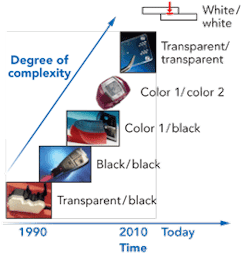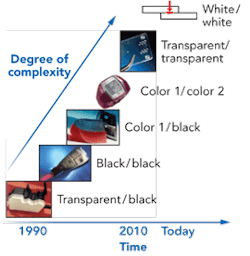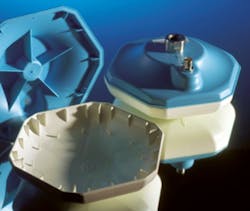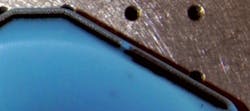Laser welding of polymers
Extending the process limits by new technologies
Andreas Rösner and Alexander Olowinsky
In the beginning of the 1990s, the laser welding of polymers was considered an emerging unconventional technology suitable only for niche applications. Today, after more than a decade of significant research effort, laser transmission welding is a well-established joining technology, and it even seriously challenges processes with an older "tradition" for plastic joining, such as adhesive bonding or ultrasonic welding. For components with a suitable design, the weld seams produced by this versatile technology are closer to perfection than the weld seams produced by any other plastic welding method.
The laser welding of polymers offers the unique advantages of: contactless processing without leaving any traces on the joining components; no particles released in the welding area; and generation of a reduced heat affected zone [1, 2]. Moreover, it is the most precise of all welding methods. Therefore, for many applications—especially in electronics—laser welding has become the dominating joining technology. This process also gains more importance in medical device manufacturing. The main advantages are the non-contact and vibration-free energy input, the precise control of the deposited energy and thus the related reproducibility and low thermal load of the parts. The decreasing costs for laser source and beam guiding system are enhancing these advantages and making laser welding even more competitive compared to other joining technologies.
By the broad acceptance of laser transmission welding in the market and thus the already existing know-how of users and equipment suppliers, new requirements coming from the parts to be joined arise as the conventional way of laser transmission welding reaches its limits.
A comprehensive approach—starting from the laser source, beam guiding, beam shaping and irradiation strategy to interaction mechanisms with the material—paves the way for these new applications and their requirements. Significant effort was made to study the laser welding of dissimilar materials leading to valuable know-how on this topic. As a result, different compatibility matrices were published. Furthermore, the latest advances in the field of material development allowed, through the use of adapted additives and pigments, the welding of a broad range of colored polymers and the welding of different color combinations as well. As shown in FIGURE 1, based on these possible color combinations, a complexity scale for the transmission laser beam welding could be determined and solved over the years.
Note that the complexity degree for the welding of the transparent/ transparent or white/ white joining configurations reaches the highest levels, and currently there are very limited practical solutions for such situations. While a laser absorber can be compounded for the welding of different color combinations with the color of the parts, there are currently no laser absorbers for the welding of transparent components. Several products from different companies are available on the market for the welding of transparent polymers such as ClearWeld, Lumogen, etc. Nevertheless, a particular slight coloring of the parts (light brown, yellow, or green, depending on the used product) cannot be avoided. To weld white material, the request for a high transmission of the laser transparent part restricts the amount of white that appears so that a high degree of white cannot be reached.
New laser wavelength
Different types of laser sources can be used for polymer welding. By the principle of laser transmission welding, the wavelength of the laser is one of the most important criteria when selecting a laser source because the optical properties of the polymers depend on the wavelength. CO2 lasers emitting at 10.6 µm are rarely used for welding as polymers show strong absorption in this wavelength range. Only thin material can be welded because almost all radiation is absorbed at the surface. However, these lasers are used for cutting. Nd:YAG lasers emitting at 1064 nm have better beam quality than diode lasers, which is why Nd:YAG lasers are often implemented in marking systems. Diode lasers are the most preferred laser source for polymer welding: High efficiency, lower costs/W, compact design, high robustness, and the ability to be fiber coupled are the most attractive advantages [1]. Beside the standard wavelength range, between 0.8 µm and 1 µm, new wavelengths in the area between 1.5 µm to 2 µm have been developed. By analysis of the optical properties, especially the absorption and the scattering coefficient [4] and adaption of the laser wavelength on the one hand and an adaption of the material on the other hand, the process limits can be extended. The following two different applications show the implementation of the described technology, both by adapting the laser wavelength and the material.
Medical industry
The necessity of using an infrared absorber to deposit the laser energy in the joining area has prevented transmission welding from many applications on medical components. FIGURE 2 presents an application where the tube end of an infusion tube and a tube connector, both consisting of additive-free polypropylene (PP), needed to be welded together. Choosing a laser source with suitable wavelength bands can be exploited in order to allow for welding without using an absorber. In the absence of an absorber, both joining component partners have equal optical properties, hence the laser radiation is no longer absorbed at their interface. Nevertheless, to deposit the laser energy into the joining area, optics with high numerical aperture (NA) are used. In the focal area, the focused beam has the highest intensity, which is set to a value sufficient to melt both joining partners at the interface. Outside the focal area, the material remains solid due to lower intensity of the beam.
The measurement of the optical properties reveals a sufficiently high intrinsic absorption of PP at 1.7 µm wavelength due to the dominating C-H-Group. Using a high-power diode laser emitting at this wavelength, both parts of the infusion tube could be welded together successfully with a process time of below 10 sec. The resulting seam is invisible from the outside and characterized by a high strength and media tightness. This process is mainly used for medical applications that often demand transparency of the components and offers a lower cost because the absorber is not used (FIGURE 2). In addition, in medical fields as well as in food packaging, the use of an absorber is usually connected with costly and time-consuming NDA-approval procedures which can also be saved by omitting the absorber.
Electronic industry:
3G-C antennas are active high-precision electronic systems developed for signal reception from satellite-based navigation systems (FIGURE 3). A tight sealing of the housing is necessary, since it is exposed to rough environmental influence. Experiments with standard wavelengths (0.8–1 µm) failed due to high absorption at the surface, leading to decomposition and marking on the surface (FIGURE 4).
An adaptation of the laser wavelength along with the material optimization made by Treffert (Bingen, Germany) leads to an enormous increase of the relevant optical properties. The lower white joining partner has sufficient absorptivity in this wavelength range, which in turn means that a good weld seam quality can be achieved even when using colored polymers with high reflectivity in the visible spectral range. By using a laser wavelength of 1.5 µm instead of 0.94 µm, the degree of transmission of the blue part is raised from 48% to 63%, and the degree of reflection is decreased from 53% to 30%. A decrease in the process-relevant scattering is also achieved, which means that the intensity in the welding area is higher. For the absorbing white part, the degree of reflection is decreased from 73% to 32%, which means that the absorption is raised. Overall, this means that 30% more laser power reaches the weld, and 120% more laser power is absorbed in the weld area as well. Therefore, the new laser wavelength allows for a stable welding process and a pressure tightness of 2.5 bar.
Using a welding station assembled at Fraunhofer ILT, the antenna's top and bottom shell are relatively positioned and clamped, and the focused laser beam is deflected along the weld contour using a galvo scanner head. To avoid spots with high radiation intensity, the focused laser beam is moved along the weld seam with a superimposed circular oscillation (TWIST method). With this technique, the increasing industrial user demands regarding weldability of colored instead of standard transparent/black combination can be achieved. Applications are expected in the field of consumer goods and medical components where a carbon black pigmentation has to pass for different reasons.
Summary
The results show that the use of new laser systems along with material development can enhance the flexibility of laser transmission welding. The variation of different colors has gained more flexibility and the limits of the process that demands a transparent and absorbing component are expanded, since the visual and laser wavelength are decoupled. This gives new design possibilities for the part construction engineers because the visual transparent part doesn't need to be the upper joining partner and the white part can be either the top or the bottom joining partner. ✺
Acknowledgments
The authors gratefully acknowledge the support for this work through the EU funded 7th framework project: "Extending the process limits of laser polymer welding with high-brilliance beam sources" (Polybright). Grant agreement number: NMP2-LA-2009-228725.
References
1. U.A. Russek, Prozesstechnische Aspekte des Laserdurchstrahlschweißens von Thermoplasten, Dissertation, RWTH Aachen University, Shaker Verlag: Aachen (2006).
2. D. Grewell, A. Benatar, and J. Park, Plastics and Composites Welding Handbook, Carl Hanser Verlag, Munich, pp. 271–311 (2003).
3. M. Sieffert, "Farbstoffe und Pigmente- von schwarz bis weiß zu kunterbunt," Aachener Laser Seminare: Aachen (2003).
4. M. Aden, A. Roesner, and A. Olowinsky, "Optical characterization of polycarbonate: Influence of additives on optical properties," J. Polymer Science: Part B: Polymer Physics 48, pp. 451–455 (2009).
Andreas Rösner([email protected]) and Dr. Alexander Olowinsky are both with the Fraunhofe Institute for Laser Technology in Aachen, Germany.
More Industrial Laser Solutions Current Issue Articles
More Industrial Laser Solutions Archives Issue Articles




